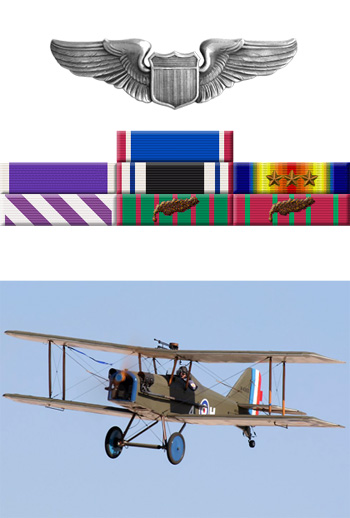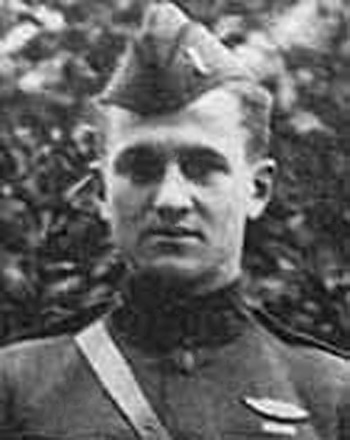John Donaldson was born on May 14, 1897, at Fort Yates, North Dakota. He enlisted in the British Royal Flying Corps in March 1917, but transferred to the Aviation Section of the U.S. Army Signal Corps the next month when America entered World War I. After completing flight training with the Royal Flying Corps, he was attached to No. 32 Squadron in France in July 1918, flying the British SE-5A. Lt Donaldson was credited with the destruction of 7 enemy aircraft in aerial combat before being shot down behind enemy lines and taken as a Prisoner of War on September 1, 1918. He escaped from a temporary prison camp on September 2, but was recaptured on September 9, only to successfully escape again on September 12, returning to Allied lines two weeks later. Capt Donaldson returned to the U.S. in October 1918, and later received the Mackay Trophy in October 1919, for winning the U.S. Army's transcontinental air race. He left the Army Air Service in 1920 and later became president of Newark Air Service in New Jersey. John Donaldson was killed in a flying accident on September 7, 1930, near Philadelphia, Pennsylvania, and was buried at the Westview Cemetery in Atlanta, Georgia.
His Distinguished Service Cross Citation reads:
The Distinguished Service Cross is presented to John Owen Donaldson, Second Lieutenant (Air Service), U.S. Army, for extraordinary heroism in action near Mont-Norte-Dame, France, July 22, 1918, when, on patrol, he attacked a formation of 20 Fokker enemy biplanes. Singling out one of the hostile machines Lieutenant Donaldson engaged it from behind, firing a short burst at close range, the plane bursting into flames and crashing to the ground. On August 8, 1918, he engaged 5 enemy scout planes over Licourt, France; singling out one and diving on it, he opened fire at close range, causing it to crash to the ground. On August 9, 1918, over Licourt, France, observing a British plane being attacked by three enemy scout planes, he immediately engaged one of the enemy, firing a long burst at very close range, the enemy plane bursting into flames and crashing to the ground. On August 25, 1918, over Hancourt, France, he attacked four Fokker enemy planes, diving into their midst and firing a short burst at one of them from a short range, destroying the plane, the pilot of which descended to safety in a parachute. On July 25, 1918, over Fismes, France, he drove down out of control an enemy Fokker plane; on August 10, over Perrone, France, one Fokker biplane; and on August 29 over Cambria, France, one Fokker biplane. In all these engagements Lieutenant Donaldson displayed the greatest devotion to duty and gallantry in the face of the enemy.
|



